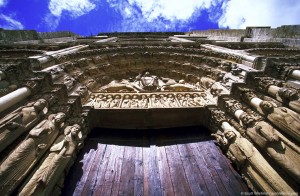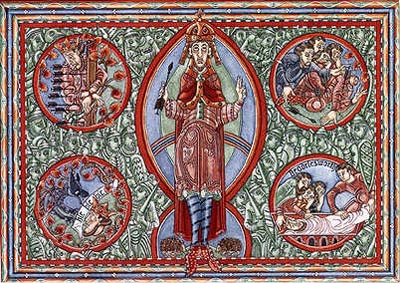 World Religions
World Religions  1 Comment
1 Comment Making Halloween Magical
 I absolutely adore Halloween. I’ve been known to skip down store aisles singing “It’s the most…wonderful time…of the year!” at the first sight of skulls and crows. I collect Halloween socks and wear them all year round. I buy gothic lanterns and creepy wall hangings and ghoulish tea towels on clearance for everyday use.
I absolutely adore Halloween. I’ve been known to skip down store aisles singing “It’s the most…wonderful time…of the year!” at the first sight of skulls and crows. I collect Halloween socks and wear them all year round. I buy gothic lanterns and creepy wall hangings and ghoulish tea towels on clearance for everyday use.
Part of this is related to Halloween’s location in my favorite season, Fall. Fall is a full-sensory extravaganza for me: crunchy leaves, crisp nose-hair-tingling morning air, spices and soups, the acrid sting of a matchstrike as I begin lighting candles again after the hot, bright summer.
But Halloween holds more meaning for me than just memories of costumes and candies past. It’s also a sacred holiday for me and other pagans, marking the beginning of new turn around the wheel of the year. Because I follow the Celtic traditions of my ancestors as they intersect with modern neo-pagan practices, I call this day Samhain (pronounced SOV-han or SOW-an, NOT SAM-HANE).
 Celebrated by many ancient agrarian cultures as a cross between New Year’s and Memorial Day, Samhain acknowledges the conclusion of the harvest, the closing down of the earth in preparation for winter, and the liminality of beginnings and endings that allows us to perceive how thin the veils are that separate us from unseen worlds around us. The costumes and the lanterns play games with concepts of finding and evading spirits passing from one state of being to the next. Even trick-0r-treating, often maligned as turning kids into greedy monsters with eroding teeth and manners, reminds us of our obligations of hospitality and the sweetness of welcome on a cold night.
Celebrated by many ancient agrarian cultures as a cross between New Year’s and Memorial Day, Samhain acknowledges the conclusion of the harvest, the closing down of the earth in preparation for winter, and the liminality of beginnings and endings that allows us to perceive how thin the veils are that separate us from unseen worlds around us. The costumes and the lanterns play games with concepts of finding and evading spirits passing from one state of being to the next. Even trick-0r-treating, often maligned as turning kids into greedy monsters with eroding teeth and manners, reminds us of our obligations of hospitality and the sweetness of welcome on a cold night.

My own monsters, as Finn and Jake from Adventure Time!, ready to storm the neighborhood and shake it for candy.
As such, it’s a powerful time for magic in every sense of the word. The topsy-turvy nature of the night always reminds me to look to the children in my life for wisdom; they have so much to teach us about taking pleasure in the moment and finding wonder in the ordinary. And you can return the favor by taking Halloween as an excuse to open the door to simple magic so they learn the spirit behind the spirits.
If your family has experienced the death of any loved ones in the past year, Samhain allows us to commemorate their life and release them with love, rather than carry the weight of grief into the new year and prevent their spirit from crossing over peacefully. Obviously, this is a complex concept, but it can be symbolized in simple ways that teach kids that grief is natural, as is letting go. If your hands are always full of the past, there’s no room to grab the future, and a ritual of remembrance and release absolves us of the guilt that often accompanies fading memory. It’s nice to look at pictures and tell stories of the departed, then perform an act that symbolizes transition: blow out a candle, throw written messages into moving water, or break a small bowl or clay pot.
Halloween is also a good day for housecleaning magic. If a child has been having difficulty with distraction, negativity, or nightmares–or if an adult wants to banish more mature worries or problems–the energy of the new year can be a powerful “disinfectant.” Go from room to room, in counter-clockwise order from the way you would face as you walk in the front door, and pass a broom over doorways and windowsills. When you end up back at the front door, sweep all the negative energy out the door, say some creative words of banishment (e.g., “Get out of my house, you horrible no-good dreams/feelings/bills!”) , and let the kids slam the door.
 Finally, it can be fun to teach kids about traditional divination magic associated with Halloween. Young boys and girls have been looking into pools of water or cutting into fruit on Halloween to tell their fortunes for centuries–that’s where bobbing for apples comes from! Spending some quiet time looking into a dish of water, mirror, or flame (safely, obviously!) often conjures hopes and fears for the future as you settle into meditation with an external focus, and talking about them works wonderful, everyday bonding magic. If you have a tarot deck, runes, or I Ching set, it can also be fun to let the child examine them and ask questions; let them offer their own interpretations and observations, and keep the atmosphere light. People are more comfortable going forward into an unknown future if they feel like they have some sort of influence over it, and even silly little scrying games can make us feel more empowered.
Finally, it can be fun to teach kids about traditional divination magic associated with Halloween. Young boys and girls have been looking into pools of water or cutting into fruit on Halloween to tell their fortunes for centuries–that’s where bobbing for apples comes from! Spending some quiet time looking into a dish of water, mirror, or flame (safely, obviously!) often conjures hopes and fears for the future as you settle into meditation with an external focus, and talking about them works wonderful, everyday bonding magic. If you have a tarot deck, runes, or I Ching set, it can also be fun to let the child examine them and ask questions; let them offer their own interpretations and observations, and keep the atmosphere light. People are more comfortable going forward into an unknown future if they feel like they have some sort of influence over it, and even silly little scrying games can make us feel more empowered.
I hope you all have a wonderful, magical Halloween!


 Reviewers have widely panned the movie as a “
Reviewers have widely panned the movie as a “









 The groundhogs’ displeasure was communicated to me. Sacrifices were made, appeasements were offered, and the Great Groundhog Spirit communed with mine. And they visited their displeasure on the Valentine-mobile no more.
The groundhogs’ displeasure was communicated to me. Sacrifices were made, appeasements were offered, and the Great Groundhog Spirit communed with mine. And they visited their displeasure on the Valentine-mobile no more.
